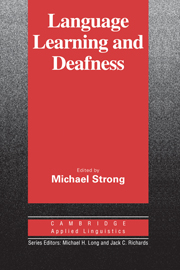Book contents
- Frontmatter
- Contents
- List of contributors
- Series editors' preface
- Preface
- SECTION I THEORETICAL ISSUES
- SECTION II RESEARCH REPORTS
- Chapter 6 An assessment of syntactic capabilities
- Chapter 7 Children's new sign creations
- Chapter 8 Linguistic and cultural role models for hearing-impaired children in elementary school programs
- Chapter 9 Acquiring linguistic and social identity: interactions of deaf children with a hearing teacher and a deaf adult
- Chapter 10 Development of vocal and signed communication in deaf and hearing twins of deaf parents
- Chapter 11 Questions and answers in the development of deaf children
- Index
Chapter 7 - Children's new sign creations
Published online by Cambridge University Press: 05 October 2012
- Frontmatter
- Contents
- List of contributors
- Series editors' preface
- Preface
- SECTION I THEORETICAL ISSUES
- SECTION II RESEARCH REPORTS
- Chapter 6 An assessment of syntactic capabilities
- Chapter 7 Children's new sign creations
- Chapter 8 Linguistic and cultural role models for hearing-impaired children in elementary school programs
- Chapter 9 Acquiring linguistic and social identity: interactions of deaf children with a hearing teacher and a deaf adult
- Chapter 10 Development of vocal and signed communication in deaf and hearing twins of deaf parents
- Chapter 11 Questions and answers in the development of deaf children
- Index
Summary
Editor's introduction
Lillo-Martin, for several years a researcher in Ursula Bellugi's laboratory at the Salk Institute, is interested in lexical innovations in ASL. Her study reported in this chapter examines the responses of groups of deaf children of deaf parents (whose native language is ASL) and deaf adults to two kinds of intriguing tests designed to elicit sign creations for new objects, persons, or machines. She analyzes the responses from her subjects in terms of a set of principles established by researchers working with English- and Hebrew-speaking children responding to similar tests, and finds that deaf children go through several stages in their acquisition of appropriated use of word-formation devices, differing in some important ways from those experienced by hearing children. For the sign language users, certain of the tasks often elicited responses that were non-word-based (in contrast to the responses from hearing subjects). This suggests that the visual modality can have a major effect on the structure and acquisition of visual languages.
One enduring aspect of language is change. Pronunciations change; structures change; and perhaps most rapidly of all, the lexicon changes. As new concepts enter the society in which a language is spoken and old ones die away or take on new importance, the vocabulary of a language grows and shifts. Speakers of every language know this (at least implicitly), and they all know what kinds of devices are used in their language to create new words and the relative productivity of each of these devices under a variety of circumstances.
- Type
- Chapter
- Information
- Language Learning and Deafness , pp. 162 - 183Publisher: Cambridge University PressPrint publication year: 1988



